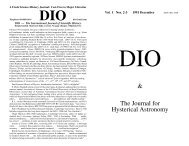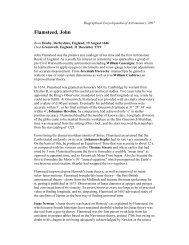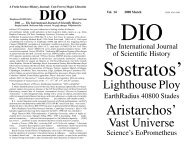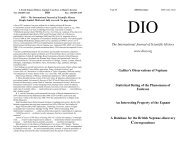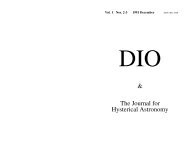DIO 1.1 - DIO, The International Journal of Scientific History
DIO 1.1 - DIO, The International Journal of Scientific History
DIO 1.1 - DIO, The International Journal of Scientific History
You also want an ePaper? Increase the reach of your titles
YUMPU automatically turns print PDFs into web optimized ePapers that Google loves.
72 1991/1/14 J.HA <strong>1.1</strong> ‡7<br />
was “an open question in science”. 13 But I will now exhibit 14 (§F3) the obvious falsity<br />
<strong>of</strong> one <strong>of</strong> the most durable and widely-accepted myths in scientific history, namely: the<br />
seemingly plausible notion that stellar parallax’s discovery in the 1830s firmly established<br />
heliocentricity.<br />
F2 To see the truth <strong>of</strong> the matter, let us start by supposing that Ptolemy had lived long<br />
enough for Bessel to face him with the reality <strong>of</strong> the stars’ tiny annual loops: would Ptolemy<br />
have suddenly given up and converted to heliocentrism? (Just as easy a question: how <strong>of</strong>ten<br />
do lawyers convert each other in the courtroom?) <strong>The</strong> visible effect <strong>of</strong> parallax is merely a<br />
looping motion <strong>of</strong> period 1 y . Add this oscillation to the star’s transverse “proper motion”,<br />
and (as a little doodling will quickly show) the net motion is: a zig-zag-zig path — direct<br />
then retrograde then direct — that is, essentially the very same path a planet describes.<br />
How could this discovery possibly discomfit Ptolemy? — hell, he lived to alibi such effects.<br />
I have asked two 1990 audiences what he would have said to stellar parallax, and (within a<br />
few seconds) both 15 figured it out (though Hist.sci never has), namely: stellar epicycles.<br />
F3 Quoting from DR’s 1976 analysis (fn 14), one sees that Ptolemy himself purveyed<br />
the common misunderstanding that Price and Johnson share (§F1):<br />
Ptolemy asserts ([Almajest 9.1]) that the planets have no detectable parallax<br />
. . . — meaning, <strong>of</strong> course, diurnal parallax. But, in fact, the planets exhibit<br />
huge annual parallax [the planets’ familiar retrograde loops] . . . . Indeed,<br />
Ptolemaic planetary astronomy can be seen as largely a design for converting<br />
the parallactic effect, <strong>of</strong> the Earth’s annual revolution, into “epicycles”<br />
(deferents, for the inferior planets) allegedly inherent in the planets’ own<br />
motion. . . . the hypothetical 19 th century Ptolemy, confronted [via Bessel’s<br />
stellar parallax data] with this familiar [annual] motion, would therefore have<br />
concluded, not for geomobility, but [instead for] a new Triumph <strong>of</strong> Ptolemaic<br />
astronomy: even the stars have our [Almajest]’s annual epicycles!<br />
F4 Planetary parallax is as real as (essentially the same as!) stellar parallax — indeed, it<br />
even looks like it (§F2). We saw above (§E) that the noneccentricity <strong>of</strong> Ptolemy’s epicycles<br />
was a figleaf (hiding Sun-planet element identities). But we now find that Ptolemy’s<br />
epicycles were themselves figleaves, hiding the most crucial phenomenon <strong>of</strong> the heliovs.-geo-centric<br />
debate: planetary parallax. I.e., a pro<strong>of</strong> <strong>of</strong> heliocentricity which is just<br />
as powerful as stellar parallax (namely, planetary parallax: planets’ retrograde loops) had<br />
always been grossly visible (requiring no telescope or heliometer) — even while geocentrists<br />
were denying that the Earth circuited the Sun . . . .<br />
G<br />
Paradigm or Modern Cleanthes<br />
G1 Thus, it is an utter misconception to suppose (with Hist.sci) that the long dominance<br />
<strong>of</strong> geocentricity was primarily based upon intellectual considerations (evidence or<br />
13 Price (“Contra-Copernicus”) at Clagett 1962 pp.215-216: Ptolemy’s Almajest “was at least original in many <strong>of</strong><br />
its parts. <strong>The</strong> magnum opus <strong>of</strong> Copernicus does not have that distinction beyond its first few pages. . . . [and its central<br />
theory, heliocentrism] could not be proved or disproved by any observation available at that time. No wonder good<br />
scientists remained skeptical until the new & decisive evidence was forthcoming. . . . Copernicus made a fortunate<br />
philosophical guess without any observation to prove or disprove his ideas . . . his work as a mathematical astronomer<br />
was uninspired. . . . his book is conservative and a mere re-shuffled version <strong>of</strong>” Ptolemy’s Almajest. Johnson (Clagett<br />
1962 p.220): “<strong>The</strong> fact that should be emphasized and re-emphasized is that there were no means whereby the validity<br />
<strong>of</strong> the Copernican planetary system could be verified by observation until instruments were developed, nearly three<br />
centuries later, capable <strong>of</strong> measuring the parallax <strong>of</strong> the nearest fixed star [Henderson’s work]. For that length <strong>of</strong> time<br />
the truth or falsity <strong>of</strong> the Copernican hypothesis had to remain an open question in science.”<br />
14 <strong>The</strong> following demonstration (§F3), regarding Ptolemy’s hypothetical incorporation <strong>of</strong> stellar parallax, was sent<br />
by DR to the 1976 IAU meeting at Grenoble via O Gingerich (Ptolemy’s chief modern public relations man) — who<br />
answered it by simply refusing to read it there.<br />
15 In the 1st instance: my fertile freshman student Josh Renzi 1990/10/12. <strong>The</strong> 2nd: a bright, enthusiastic Amer<br />
Astron Soc audience at the 1990/10/22 AAS Planetary Sciences Division meeting, Charlottesville, VA.<br />
1991/1/14 J.HA <strong>1.1</strong> ‡7 73<br />
“paradigms”). When Aristarchos first broached the heliocentric theory publicly, he was not<br />
crushed by logic or lack <strong>of</strong> crucial experiments. He was simply threatened.<br />
G2 From Plut Mor 923, we learn that Cleanthes (the leader <strong>of</strong> the Stoics) recommended<br />
“an action for impiety against Aristarchus the Samian on the ground that he was disturbing<br />
the hearth <strong>of</strong> the universe because he sought to save phenomena by assuming that<br />
the heaven is at rest while the earth is revolving along the ecliptic and at the same time is<br />
rotating about its own axis.”<br />
G3 What killed ancient heliocentrism was not evidence. It was force. From the hemlockian<br />
fate <strong>of</strong> Socrates, we know what a charge <strong>of</strong> “impiety” led to. Had heliocentrists<br />
persisted, armed policemen attached to the prevailing theocratic dictatorship would have removed<br />
the <strong>of</strong>fenders to prison — perhaps en route to execution. What has this brutal fact got<br />
to do with: mythical “decisive” new evidence (for which good-skeptical-scientists allegedly<br />
waited), “paradigms”, “whiggism” 16 — and all the other highflown alibis & cult-fads that<br />
Hist.sci archons have for decades hauled out to try to pretend that there is something <strong>of</strong><br />
genius in Ptolemy’s geocentric contraption?<br />
G4 Ptolemy’s real genius was political. He made himself the advocate — the paid<br />
lawyer — for the dominant government view, which was effectively: popular realization<br />
that the Earth is not the universe’s center could be corrupting to public morals. (Given<br />
the course <strong>of</strong> history since Copernicus: I won’t take a firm position against that viewpoint.<br />
However, the truth and the beneficence <strong>of</strong> an idea are two separate issues.) <strong>The</strong> enormity <strong>of</strong><br />
the gulf, that separates so many scientists from the currently fashionable Hist.sci center, is<br />
illustrated by a simple consideration here: obviously, scholars <strong>of</strong> principle ought to condemn<br />
(not alibi & laud) Ptolemy’s convenient going-along with powerful false orthodoxy (hiding<br />
heliocentricity beneath the ad hoc layers <strong>of</strong> a gov’t-certified figleaf salad). (To anyone<br />
among <strong>DIO</strong>’s scientist-readers who has behaved ethically, perhaps courageously, in the face<br />
<strong>of</strong> an unprincipled power-type: stop to consider how Hist.sci will record your respective<br />
careers.) What is it about certain Hist.sci archons that attracts them so magnetically to the<br />
seemingly-repellant task <strong>of</strong> glorifying a sell-out scholar? (Hist.sci’s peculiar compulsion in<br />
this connection is especially incongruous since the Hist.sci field is so admirably bereft <strong>of</strong><br />
careerists — and indeed is justly famous among scientists for its quintessential rectatude.)<br />
G5 To investigate the self-evident ancient-modern parallel here a bit further: how have<br />
Hist.sci archons treated modern skeptics regarding Ptolemy’s pretensions? [a] Flee debate<br />
for 20 y . [b] Alibi Ptolemy with the same 17 prejudiced intensity he exhibited when explaining<br />
away planetary parallax. [c] Slander dissenters in as vile a fashion as possible. (E.g., ‡1 §C7<br />
& ‡3 §D.) [d] Apply totalitarian force: threaten and suppress 18 (& attack in politically safe<br />
forums).<br />
Cleanthes lives.<br />
16 E.g., O Gingerich to DR 1979/12/10.<br />
17 Quoting from DR’s 1990 abstract (BullAAS 22.3:1040) for this paper: If used with great care, Ptolemy’s Alm<br />
is an invaluable sourcebook for our knowledge <strong>of</strong> ancient astronomy. But his famous patchwork celestial model’s<br />
sole genuine claim to greatness is merely as a classic study in adamant unfalsifiability. <strong>The</strong> same might be said <strong>of</strong><br />
the equally motley zoo <strong>of</strong> alibis for Ptolemy, conjured up by his modern team <strong>of</strong> admirably imaginative “historian”<br />
defense-lawyers.<br />
18 Details: ‡6 fn 15 & ‡5 fn 24.




